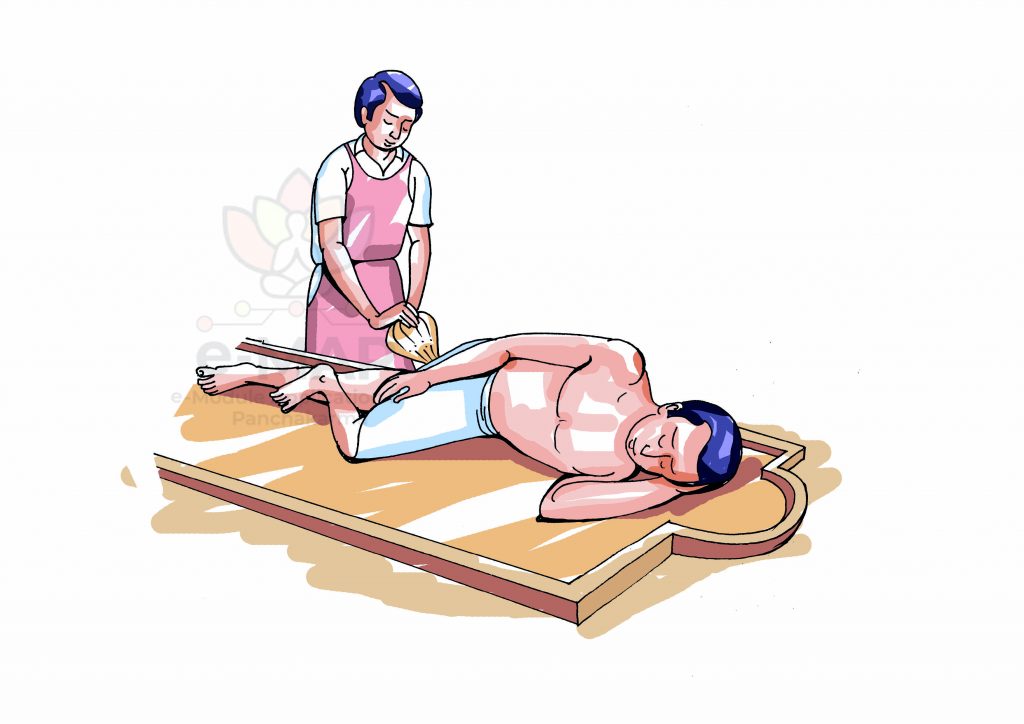
PG Module 6
BASTI KARMA

EXPLANATORY NOTES
Uttarabasti is a type of Basti Upakrama, Uttarabasti is an important unique Āyurvedaprocedure, which has described in Āyurvedaclassics very descriptively. It is mentioned for the Genito–urinary disorders of both the males and the females. Basti preparations are mentioned in the classics but in many a cases Uttarabasti is to be recommended because of its higher efficacy. The Basti which is given through Uttaramārgaor UtkliṣṭaAvayava or therapeutic procedure having Śreṣṭha properties is termed as Uttarabasti.[i]ĀcāryaVāgbhaṭasays that the one which is administered after the Nirūha Basti procedure is known as Uttarabasti. [ii]
[i]Vaidya YadavajiTrikamjiācārya, Caraka Samhita with āyurvedadīpikā commentary of Cakrapānidatta revised by Caraka and Dṛḍhabala,reprint -2011, New delhi, Caukambhasurbhārtiprakāśan, Siddhisthāna, Chapter-9, śloka-50, p.720
[ii]VriddhaVāgbhata,Aṣtāngaśangraha With Sasilekha Sanskrit Commentary By Indu Edited By Śivaprasadśarma,Caukhamba Sanskrit Series,Varanasi,Third Edition Sutrasthāna, Chapter28, śloka-9,P-504
उत्तरबस्तिसञ्ज्ञाउत्तरमार्गदीयमानतया, किंवाश्रेष्ठगुणतयाउत्तरबस्तिः||
(Cha. Si. 9/50, Cakrapāṇi commentary)
The Basti which is given through Uttaramārgaor the therapeutic procedure having Śreṣṭhaproperties is termed as Uttarabasti.
सनिरूहादुत्तरमुत्तरेणवामार्गेणदीयतइत्युत्तर-बस्तिः|| (A. S. Su. 28/11)
Basti which is administered afterNiruha Basti and through the Uttaramārga.
गुदादुत्तरेणमार्गेणदीयतइत्युत्तरबस्तिः| (A. H. Su. 19/70, Arunadatta commentary)
The administration of drugs through the orifice above Gudamārga.
- On the basis of form of drug to be administered
उत्तरबस्तिरपिस्नेहोऽनुवासनवच्छोधनंनिरूहवदपिकेचिदाहुः|| (A. S. Su. 28/10)
On the basis of form of drug to be administered Uttarabasti may be classified as SnaihikaUttarabasti and NirūhikaUttarabasti
- SnaihikaUttarabasti – The Uttarabasti procedure where only Sneha Dravyas are used is called as SnaihikaUttarabasti.
- NirūhikaUttarabasti – The Uttarabasti procedure where only KaṣāyaDravya are used. There is no mentioning of addition of Madhu, Sneha, Kalka etc, which are being added commonly in Niru
- On the basis of route of administration
On the basis of route of administration, it is classified as:
- MutrāśayagataUttarabasti – The administration of drugs through urethral route
- YonigataUttarabasti – The administration of drugs through vaginal route
- GarbhāśayagataUttarabasti – The administration of drugs through uterine route
- On the basis of gender
- Male Uttarabasti – Mutrāśaya(vesicular/urethral/genital)
- FemaleUttarabasti – Yoni mārga and Garbhāśaya (vesicular/urethral/genital)
शुक्रंदुष्टंशोणितंचाङ्गनानांपुष्पोद्रेकंतस्यनाशंचकष्टम् |
मूत्राघातान्मूत्रदोषान्प्रवृद्धान्योनिव्याधिंसंस्थितिंचापरायाः ||
शुक्रोत्सेकंशर्करामश्मरींचशूलंबस्तौवङ्क्षणेमेहनेच |
घोरानन्यान्बस्तिजांश्चापिरोगान्हित्वामेहानुत्तरोहन्तिबस्तिः || (Su. Chi. 37/125-126)
According to ĀcāryaSuśruta, Uttarabasti is indicated in vitiation of semen in men, vitiation of menstrual blood in women, untimely menstruation (menorrhagia), loss of menstruation (amenorrhea) and painful menstruation (dysmenorrhea), retention of urine, disorders of urine, vaginal diseases, non-expulsion of placenta, untimely elimination of semen, urinary gravel and calculi, pain in the bladder, groins and penis, other dreadful diseases of bladder and diabetes.
बस्तिजेषुविकारेषुयोनिविभ्रंशजेषुच||
योनिशूलेषुतीव्रेषुयोनिव्यापत्स्वसृग्दरे|
अप्रस्रवतिमूत्रेचबिन्दुंबिन्दुंस्रवत्यपि||
विदध्यादुत्तरंबस्तिंयथास्वौषधसंस्कृतम् | (Cha. Si. 9/63-64)
According to ĀcāryaCaraka, Uttarabasti is indicated in diseases of urinary bladder, prolapse of uterus, excruciating pain in the uterus, gynecological disorders, menorrhagia, anuria and dribbling of urine.
बस्तौरोगेषुनारीणांयोनिगर्भाशयेषुच| (A. H. Su. 19/70)
Uttarabasti should be administered in diseases of the urinary bladder, vagina and uterus in women.
Prameha – as prameha is not a roga which affects only Basti, there are involvement of Dhātus also.
| Contraindicated conditions
| |
Urinary system
| Reproductive system | |
Male Uttarabasti |
· Urethral stricture · Bleeding disorders · Carcinoma of the bladder · Hypo/epispadiasis
|
· Carcinoma of penis · Bleeding disorders
|
Female Uttarabasti |
· Bleeding disorders · Carcinoma of the bladder
|
· Hypersensitivity · Carcinoma cervix · Heavy bleeding · Virginity · Menorrhagia · Recto-vaginal fistula[i]
|
[i]Dr BA. Lohith.A text book of Panchakarma,Chaukhambhapublication,Edition 2016,P 334
It has two parts
- Basti Netra
- Basti Puṭaka
BASTI NETRA
Synonym: Puṣpa Netra
आतुराङ्गुलमानेनतन्नेत्रंद्वादशाङ्गुलम्|
वृत्तंगोपुच्छवन्मूलमध्ययोःकृतकर्णिकम्||
सिद्धार्थकप्रवेशाग्रंश्लक्ष्णंहेमादिसम्भवम्|
कुन्दाश्वमारसुमनःपुष्पवृन्तोपमंदृढम्|| (A. H. Su. 19/72)
The male Uttarabasti Netra should be 12 Aṅgula in length, in terms of patient’s own fingers. It should be round shape resembling a cow’s tail at its base and endowed with a ridge in its middle and its tip should be capable of permitting a grain of mustard. The Netra should be smooth and made from metals like gold., silver, copper etc. and resembling the shape of the stalk of flowers such as Kunda, Aśvamāra and Sumana and should be strong.
पुष्पनेत्रंतुहैमंस्याच्छ्लक्ष्णमौत्तरबस्तिकम्||
जात्यश्वहनवृन्तेनसमंगोपुच्छसंस्थितम्|
रौप्यंवासर्षपच्छिद्रंद्विकर्णंद्वादशाङ्गुलम्|| (Cha. Si.9/50)
According to ĀcāryaCaraka, Uttarabasti Netra should be prepared of gold or silver, and it should be smooth. Its tip should be of the size of the flower stalk of Jāti or Aśvahana, and in shape it should be tapering like the cow’s tail. It must have a hole in the middle which should allow mustard seed to pass through. It should have two rings, and its length must be 12 Aṅgulas.
चतुर्दशाङ्गुलंनेत्रमातुराङ्गुलसम्मितम्|
मालतीपुष्पवृन्ताग्रंछिद्रंसर्षपनिर्गमम्|| (Su. Chi. 37/101)
The Basti Netra for male Uttarabasti should be 14 Aṅgula long. Its diameter is the thickness of the patient’s finger. The thickness of the tip is thickness of the stalk of Mālati flower and the orifice at the tip permitting a mustard seed to pass through.
Characteristics of Netra for male
Material |
Hema (gold), Raupya (silver), copper, wood, bone, bamboo |
Length |
12 Aṅgula (Caraka and Vāgbhata)[i] 14 Aṅgula (Suśruta) |
Structure |
Gopucchasaṃsthita. Agra (tip) – should be similar to the buds ofJātipuṣpa/ Aśvahana Mūla (base) – should have a broad base with tapering end so that it resembles Gopuccha |
Chidra |
Sarṣapavāhi (internal orifice) (Vāgbhata, Caraka) MālatipuṣpaVṛntāgra (Suśruta) |
Karṇika |
2 Karṇikas One at the base to tie the Putaka and the other at the level of 6 Aṅgulas (which is the normal size of the phallus) from the tip indicating the length to be inserted. 3 karṇikas (Cakrapāṇi) |
Length of insertion (Netra praṇidhāna) |
Cakrapāṇi – length of Meḍhra Dalhana – 7 Aṅgula Kṣārapāṇi – 4/5/6/7 Aṅgula |
BASTI PUṬAKA
औरभ्रःशौकरोवाऽपिबस्तिराजश्चपूजितः |
तदलाभेप्रयुञ्जीतगलचर्मतुपक्षिणाम् ||
तस्यालाभेदृतेःपादोमृदुचर्मततोऽपिवा | (Su. Chi. 37/107)
Urinary bladder of either a camel, boar or goat is preferable as enema bag. In their absence, the skin of the neck of birds may be used. In the non-availability of any of the above, bag made from soft leather may be used.
It should be smooth, devoid of Sirā, processed with KaṣāyaDravya, clean and devoid of foul smell.
[i] Vaidya YadavajiTrikamjiācarya, Caraka Samhita with āyurvedadīpikā commentary of Cakrapānidatta revised by Caraka and Dṛḍhabala,reprint -2011, New delhi, Caukambha surbhārti prakāśan, Siddhisthāna,Chapter-9, Sloka-50-51, p
It has 2 parts
- Basti Netra
- Basti Puṭaka
BASTI NETRA
Synonym: Puṣpa Netra
नेत्रंदशाङ्गुलंमुद्गप्रवेशंचतुरङुलम्|
अपत्यमार्गेयोज्यंस्याद्ह्यङ्गुलंमूत्रवर्त्मनि||
मूत्रकृच्छ्रविकारेषु, बालानांत्वेकमङ्गुलम्| (A. H. Su. 19/79)
The female Uttarabasti Netra should be 10 Aṅgula in length. Its tip permitting the entry of a grain of Mudga (green gram). It should be inserted to a length of 4 Aṅgula in case of vaginal passage and to a length of 2 Aṅgula in case of urethral passage in diseases like dysuria etc and in case of children, it shall be 1 Aṅgula.
पुष्पनेत्रप्रमाणंतुप्रमदानांदशाङ्गुलम्||
मूत्रस्रोतःपरीणाहंमुद्गस्रोतोऽनुवाहिच|
अपत्यमार्गेनारीणांविधेयंचतुरङ्गुलम्||
द्व्यङ्गुलंमूत्रमार्गेतुबालायास्त्वेकमङ्गुलम्| (Cha. Si. 9/65-66)
Puṣpanetra for women should be 10 Aṅgula in length. In circumference, it should be of the size of their urethral canal. The hole in the middle of the nozzle should be spacious enough to allow the passage of mudga (green gram).
For giving Uttarabasti in the genital organ of adult women, the nozzle should be inserted up to 4 Aṅgulas, and for Uttarabasti in their urethral passage, it should be inserted up to 2 Aṅgulas. In the case of young girls, the Netra should be inserted up to 1 Aṅgula in their urethral passage.
निविष्टकर्णिकंमध्ये, नारीणांचतुरङ्गुले |
मूत्रस्रोतःपरीणाहंमुद्गवाहिदशाङ्गुलम् ||
मेढ्रायामसमंकेचिदिच्छन्तिखलुतद्विदः | (Su. Chi. 37/103-104)
Netra for men should have the Karṇika in the middle and in women, it should be at a distance of 4Aṅgula from the tip. Netra should have the diameter of the urinary passage, 10 Aṅgula long and with the orifice allowing a green gram to pass through. Some others say it should have the external diameter equal to the size of Meḍhra.
Characteristics of Netra for female
Material | Hema (gold), Raupya (silver), copper, wood, bone, bamboo |
Length | 10 Aṅgula (AH, Cha)
|
Structure | Gopucchasaṃsthita Agra (tip) – should be similar to the buds of[i]Jatipuṣpa/ Aśvahana Mūla (base) – should have a broad base with tapering end so that it resembles Gopuccha |
Chidra | Mūtramārga – Mudgavāhi
|
Karṇika | 2 Karṇikas (AH & Cha) One at the base to tie the Putaka and the other at the level of 4 Aṅgulas (which is the normal size of the phallus) from the tip indicating the length to be inserted.
|
Length of insertion (Netra praṇidhāna) | Mūtramārga Bāla (up to 12 years) – 1 A mūtramārga –2 A Apatyamārga – 4 A |
BASTI PUṬAKA
औरभ्रःशौकरोवाऽपिबस्तिराजश्चपूजितः |
तदलाभेप्रयुञ्जीतगलचर्मतुपक्षिणाम् ||
तस्यालाभेदृतेःपादोमृदुचर्मततोऽपिवा | (Su. Chi. 37/107)
Urinary bladder of either a camel, boar or goat is preferable as enema bag. In their absence, the skin of the neck of birds may be used. In the non-availability of any of the above, bag made from soft leather may be used.
It should be smooth, devoid of Sirās, processed with Kaṣāyadravya, clean and devoid of foul smell.
[i]Vaidya Yadavaji Trikamji ācharya, Caraka Samhita with āyurveda dīpikā commentary of Cakrapānidatta revised by Caraka and Dṛḍhabala,reprint -2011, New delhi, Caukambha surbhārti prakāśan, Siddhisthāna,, Chapter-9, Sloka-50-51, p720
- Stainless steel Uttara basti yantra
- Plastic Uttara basti yantra
- Rubber bell vaginal douche
- Simple rubber catheter and plastic syringe
- I V cannula
- Infant feeding tube
- IUI cannula



